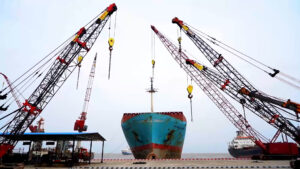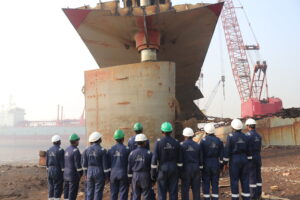- Leading ship recycling company and has been established in 1983
Mapping the Supply Chain of Ship Recycling
Mapping the supply chain of ship recycling – Ship recycling is dismantling vessels for the purpose of recovering metal scrap and other valuable materials. One of the most important steps in the entire ship recycling is the shipbreaking process in which most of the regulation is required. Mapping the Supply Chain of Ship Recycling is the study of the various steps that take place during ship recycling. It includes all the rules and regulations, the dismantling of ships, and the recovery of metal scrap and steel.
If you wish to know more about ship recycling, R.L. Kalthia has mapped the supply chain of ship recycling. It will give you a general view of the entire journey of end-of-life-vessels.

Beginning of Ship Lifecycle and Decommissioning
The supply chain of ship recycling begins with the arrival of end-of-life vessels at the shipyards. The recycling of the ship starts with the shipowner who is disposing of the vessel and ends with the customer interested in buying the steel and metal scrap recovered from the ship. The decision to decommission a ship is complex and influenced by a variety of factors. The decision can be influenced by economic considerations, adherence to the regulations, technological advancements, and environmental concerns.
Some of the factors influencing the decommissioning of ships and announcing them as end-of-life vessels are briefed below:
- Ships have a limited working time span and become prone to wear and tear with time.
- Increased and expensive repairing costs of ships can make them a burden and eligible for shipbreaking.
- Economic factors such as fuel prices, and changes in supply and chain demands make it economically rational to abandon the ships.
- The demand for specific types of ships can change with economic conditions and industry requirements.
- A high resale value of ships can compel the shipowner to decommission to enjoy financial benefits.
Breaking Down the Shipbreaking Process
One of the major components of the supply chain of ship recycling is the dismantling of end-of-life vessels. It comprises various steps undertaken under the guidance of many experts. The shipbreaking process begins with the arrival of the vessel at the shipyard. Before starting the shipbreaking process, the vessel undergoes preliminary inspection to maintain an Inventory of hazardous material (IHM). The dismantling process is briefed below:
Removal of Hazardous Material
- End-of-life vessels arrive at the shipbreaking yard and are dragged to the shore.
- After the preliminary inspection, all the hazardous materials are inspected and noted down in the Inventory of Hazardous Materials (IHM)
- All the hazardous materials such as asbestos, Polychlorinated biphenyls(PCBs), and lead are recovered from the ship and disposed of properly while performing all the precautionary measures for the worker’s safety and environmental protection.
Dismantling and Cutting Scrap Material
- The steel and metal covering the vessel are dismantled using various cutting technologies such as dry docking method, inter tidal landing method, artificial reefing, and hulking.
- Different materials such as steel, plastic, and electronics are separated from each other.
Material Separation and Recovery
- After the material is recovered in the large pieces of scarp it is separated into different categories.
- A wide range of recovery methods are used to recover the material and further sell it at profitable margins in the market.
Besides, these crucial components the mapping of ship recycling also includes the key aspects of worker’s safety, waste management, and environmental and safety considerations.
Impact of Regulations on the Supply Chain Management

Once the need for regulating the ship recycling process was globally recognized, many international bodies and organizations were established. Many international conventions such as the Hong Kong International Convention, Basal Convention, and EU Ship Recycling Regulations were introduced. The regulations laid by these organizations have a vital impact on the supply chain and certification of facilities for ship recycling.
These regulations are framed to encourage worker safety, ethical shipbreaking practices, and environmental protection throughout the ship recycling process. They give a roadmap on how ships are dismantled, materials are handled, and waste is managed, promoting sustainable shipbreaking. The key components of the supply chain of ship recycling influenced by the regulations are briefed below:
- The main objective of the regulations is to minimize the environmental impact of ship recycling.
- The regulations tackle the waste disposal problems in ship recycling and outline different methods for proper disposal.
- The guidelines also ensure that the worker’s safety is never compromised and proper measures are taken for their safety.
- Some regulations are focused on shipbreaking techniques to reduce noise, emissions, and potential threats to the workers.
Conclusion
Mapping the supply chain of ship recycling is a complex process involving stakeholders and regulations that lay guidelines to promote the sustainable and responsible dismantling of ships. The journey of a ship from its active services to the recycling stage is about safeguarding our oceans, reducing environmental impact, and building a future where responsible supply chain management is a norm in the shipbreaking industry. The insights from learning about the supply chain of ship recycling can encourage shipyard owners to adopt sustainable shipbreaking practices.